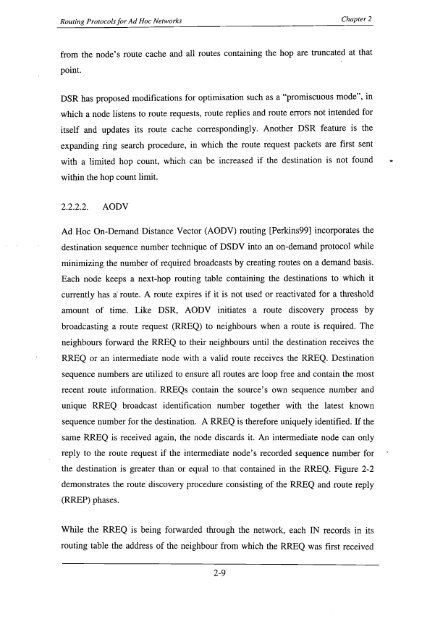Gugrajah_Yuvaan_ Ramesh_2003.pdf
Gugrajah_Yuvaan_ Ramesh_2003.pdf
Gugrajah_Yuvaan_ Ramesh_2003.pdf
You also want an ePaper? Increase the reach of your titles
YUMPU automatically turns print PDFs into web optimized ePapers that Google loves.
Routing Protocols for Ad Hoc Networks<br />
Chapter 2<br />
from the node's route cache and all routes containing the hop are truncated at that<br />
point.<br />
DSR has proposed modifications for optimisation such as a "promiscuous mode", in<br />
which a node listens to route requests, route replies and route errors not intended for<br />
itself and updates its route cache correspondingly. Another DSR feature is the<br />
expanding ring search procedure, in which the route request packets are first sent<br />
with a limited hop count, which can be increased if the destination is not found<br />
within the hop count limit.<br />
2.2.2.2. }\()D"<br />
}\d Hoc ()n-Demand Distance 'lector (}\()D") routing [Perkins99] incorporates the<br />
destination sequence number technique of DSD" into an on-demand protocol while<br />
minimizing the number of required broadcasts by creating routes on a demand basis.<br />
Each node keeps a next-hop routing table containing the destinations to which it<br />
currently has a" route. )\ route expires if it is not used or reactivated for a threshold<br />
amount of time. Like DSR, }\()D" initiates a route discovery process by<br />
broadcasting a route request (RREQ) to neighbours when a route is required. The<br />
neighbours forward the RREQ to their neighbours until the destination receives the<br />
RREQ or an intermediate node with a valid route receives the RREQ. Destination<br />
sequence numbers are utilized to ensure all routes are loop free and contain the most<br />
recent route information. RREQs contain the source's own sequence number and<br />
unique RREQ broadcast identification number together with the latest known<br />
sequence number for the destination. )\ RREQ is therefore uniquely identified. Ifthe<br />
same RREQ is received again, the node discards it. An intermediate node can only<br />
reply to the route request if the intermediate node's recorded sequence number for<br />
the destination is greater than or equal to that contained in the RREQ. Figure 2-2<br />
demonstrates the route discovery procedure consisting of the RREQ and route reply<br />
(RREP) phases.<br />
While the RREQ is being forwarded through the network, each IN records in its<br />
routing table the address of the neighbour from which the RREQ was first received<br />
2-9
















